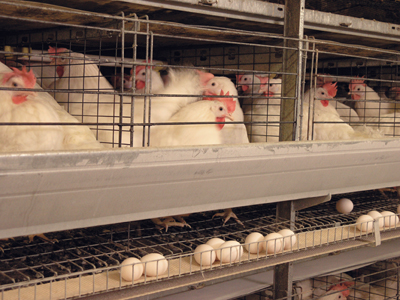
Feed Efficiency
By Paul B. Siegel
Features New Technology ProductionThe challenge from a breeding and genetic viewpoint
Although the breeding of poultry as a source of food dates back
thousands of years, scientific and technical aspects of genetic
variation are more recent per Darwin (who was born 200 years ago –
1809) and Mendel (1822). Even more recent is the industrial production
of the poultry meat and egg industries.
Although the breeding of poultry as a source of food dates back thousands of years, scientific and technical aspects of genetic variation are more recent per Darwin (who was born 200 years ago – 1809) and Mendel (1822). Even more recent is the industrial production of the poultry meat and egg industries.
 |
|
| Efficiency of Feed Utilization The challenge to geneticists, whether breeding for meat or for eggs, is to balance growth, reproduction, and well-being for different climates and differing availability of feedstuffs. Advertisement
|
Changes during the current millennium have been most dramatic with commercial poultry breeding now in the hands of a few multinational organizations that employ highly trained staffs (including nutritionists) and utilize large populations with intense selection. Computer technology and jet aircraft have allowed for central facilities with satellite operations and the same stocks available globally.
The challenge to producers and nutritionists is that feedstuffs are not the same worldwide. Thus the challenge to geneticists, whether breeding for meat or for eggs, is to balance growth, reproduction, and well-being for different climates and differing availability of feedstuffs. Although performance per se may be less relevant in an industry where returns and consumer preferences are becoming increasingly important, efficient feed utilization is critical.
Breeding and nutritional accomplishments are evaluated by needs of industry, which means that emphasis will be on efficiency of feed utilization. Criteria involved are not just production units (i.e., yield, eggs produced, health), but food safety, less waste (environmental issues), and judicious use of feed additives. These are items where breeding and nutrition regimes should be in concert. Thus, although the genetic stock may be the foundation, it is only one section of the orchestra.
 |
Components such as nutrient composition of the diet, feeding regime, feed intake behavior, rate of feed passage, changing microflora in the host gut, chronological age and physiological stage of the host are parts of a paradigm that is continually in flux. Then there are, at a different level, geneticists constantly tinkering with breeding programs to better fit market demands. Changes are occurring both in and over time.
Although we are moving into (or perhaps already in) a molecular age, the heart of any poultry breeding and genetics program is quantitative. Most production traits are influenced by polygenic inheritance and networks of genes. Nutritional programs will vary not only among meat and egg stocks, but within each stage in life. Viewed from two levels we must first remember that there is no internal description of the genotype that can be separated physically from the environment. Second, the genetic description of the organism (i.e., its genome) is not by itself sufficient to produce an individual. This is because there is additional information in the structure and systems that interpret genetic information (i.e., various regulatory systems, networks of regulation, stage in life).
As we move toward to end of the first decade of the 21st century, genetic plasticity, robustness, and adaptability of domestic poultry remain considerable.
The sequencing of the chicken genome has facilitated recent experiments involving feed intake behaviour and digestive efficiency at a molecular level. Evidence shows that in addition to differences among populations, age has an influence on gene expression as well as receptors. These factors increase complexity in the design of breeding programs. A recent study evaluated the influence of dietary protein quality on peptide, amino acid, and monosaccharide transporters in the small intestine of two genetically selected broiler lines.1
Although the lines originated from a common population, selection for over 10 generations was practiced under different nutritional regimes. Line A was fed a corn-soy diet while Line B was fed a wheat diet with amino acid concentrations 15-20 per cent higher than for Line A. Whereas intestinal weight expressed on a body weight basis was similar for both lines, selection had changed expression of nutrient transporters.
Differences, accentuated when fed deficient diets, were masked when fed balanced diets. The intestinal transporter PepT1 had greater expression in feed restricted than ad libitum fed chickens. When we compared PepT1 across ages in our lines that differed in feed intake, similar results were noted, with the cross of the lines intermediate.2 The caveat, however, was that age and part of the small intestine determined the degree to which differences were noted.
Using these same lines we measured gene expression associated with neural systems regulating feeding behavior and lipid metabolism.3 Noted were different trajectories depending on physiological stage in the life cycle. If these findings are valid, then multiple expression differences may be difficult, based on present knowledge, to observe phenotypically.
As stated earlier, breeders have emphasized enhanced feed efficiency in the development of commercial meat and egg poultry. There has been criticism in some quarters that these highly selected chickens have difficulty in making dietary choices unless the diets are deficient in specific nutrients. We wished to test this thesis and took broilers from three genetic stocks known to differ in growth potential and fed them either a single diet or a choice of two diets that differed in protein and energy. The choice diets were formulated so that when mixed in specific proportions they provided a single diet with recommended levels of protein and energy to enhance growth and feed efficiency (body weight/feed consumed). Broilers fed the single diet were heavier with enhanced feed efficiency and more breast meat and less fat than those provided choice diets.
There was no difference between groups in immunocompetence as measured by response to sheep red blood cell antigen. The “bottom line” was that intense selection for growth and feed efficiency to market weight did not rule out the chickens’ ability to discriminate among diets. Moreover, diets formulated to be economically sound were not consistent with the broiler preferences. These results suggest that broilers may innately, when provided a choice, select diets with long-term survival rather than economic benefits.
Growth and reproduction are complex processes directed by the genetic code of the individual. There is a definite sequence and synchrony to growth with formation of skeletal, muscle, and adipose tissue. Likewise, there is the sequence and synchrony associated with egg production. Competing for resources available for growth and/or egg production are body functions including maintenance and health. Allocation of resources at any point in time is not independent of an individual’s past history and stage in life as well as the past history of the population.
In the fowl, resources during embryonic development are fixed by what is available from the egg. Posthatch there is the transition to utilization of external feed. During the early posthatch period, supply organs (e.g. intestine and liver) grow faster than demand organs (e.g. muscle, fat, and ovary). This pattern of growth is critical because the “engine” must have adequate capacity before carrying “cargo”. To enhance feed efficiency, geneticists and nutritionists need collaboration depending on the feedstuffs available and supplementation of nutrients.
Whether or not breeders “tailor” their stocks to specific markets influenced by availability of feedstuffs will depend on the size of market. Regardless, challenge to the breeder will be to have products that are robust and nutrient friendly.
References
Presented at the 2009 Midwest Poultry Federation Convention
1 Gilbert et al. J. Nutr., 2008. 138: 262-271
2 Mott et al., 2008. Poultry Sci. 87: 2215-2224
3 Ka et al., 2009. J. Neuroendocrin. In press
Print this page